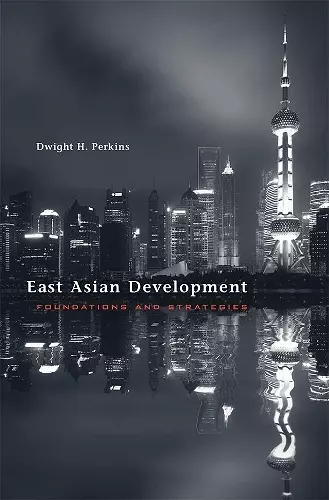East Asian Development
Foundations and Strategies
Format:Hardback
Publisher:Harvard University Press
Published:28th Oct '13
Currently unavailable, and unfortunately no date known when it will be back

In the early 1960s, fewer than five percent of Japanese owned automobiles, China’s per capita income was among the lowest in Asia, and living standards in South Korea’s rural areas were on par with some of the world’s poorest countries. Today, these are three of the most powerful economies on earth. Dwight Perkins grapples with both the contemporary and historical causes and consequences of the turnaround, drawing on firsthand experience in the region to explain how Asian countries sustained such rapid economic growth in the second half of the twentieth century.
East Asian Development offers a comprehensive view of the region, from Japan and the “Asian Tigers” (Hong Kong, Singapore, Taiwan, South Korea) to Indonesia, Vietnam, Thailand, Malaysia, and China—a behemoth larger than all the other economies combined. While the overall picture of Asian growth is positive, no single economic policy has been effective regionwide. Interventionist policies that worked well in some countries failed elsewhere. Perkins analyzes income distribution, to uncover why initially egalitarian societies have ended up in very different places, with Japan, for example, maintaining a modest gap between rich and poor while China has become one of Asia’s most unequal economies.
Today, the once-dynamic Japanese and Korean economies are sluggish, and even China shows signs of losing steam. Perkins investigates whether this is a regional phenomenon or typical of all economies at this stage of development. His inquiry reminds us that the uncharted waters of China’s vast economy make predictions of its future performance speculative at best.
During the past half century, the global economy’s most impressive growth engines have largely resided in East and Southeast Asia. To explain the extraordinary performance of these Asian economies, Perkins draws on academic research and on his own decades-long experience as an adviser to developing countries. It comes as no surprise that the explanations vary over time and from economy to economy. Also unsurprising is the good deal of attention that Perkins pays to China, the largest of the economies examined (India and the rest of South Asia are not included). Perkins predicts that China’s outsized economic growth will decline significantly in the years ahead, perhaps to an annual rate of five percent, which would still be high by world standards. He also helpfully places China in the context of other successful Asian countries, in which, Perkins argues, high growth has been aided by a strong emphasis on education. Asian countries’ development of their nonagricultural labor forces has also played an important role, as has their steady engagement with the global economy. -- Richard N. Cooper * Foreign Affairs *
Perkins marries an ability to write intelligibly for a popular audience to a decent grounding in the historical background of Asian societies and polities. Examining cross-national economic development in the two regions over the past half century, Perkins notes that sensational rates of growth have characterized not only Japan, South Korea, Taiwan, Hong Kong, and China, but also Malaysia, Thailand, Vietnam, and Singapore. His analysis of what accounts for such success begins with broad brushstrokes of regional history; brings up the general relevance of quantitative economic yardsticks of growth; and discusses the role of state intervention in fostering or hindering growth. Separate attention is then devoted to China and Vietnam and their tortuous journey from Soviet-style command systems to market economies. The book thus serves well as a historically sensitive, comparative primer on the economic dynamics of East and Southeast Asia. -- R. P. Gardella * Choice *
The topic of East Asian development is an almost irresistible magnet for over-strong assertions and facile generalizations. In this analysis informed by a long career working on the region, Dwight Perkins provides the necessary antidote. Even specialists will learn much from Professor Perkins’s deeply contextualized, historically-informed comparisons. -- Barry Eichengreen, author of Exorbitant Privilege: The Rise and Fall of the Dollar and the Future of the International Monetary System
A remarkable tour de force. Drawing upon a wealth of knowledge and experience accumulated through close engagement with East Asia during an extraordinarily eventful half century, Dwight Perkins presents a panoramic overview of the region’s economic transformation from the 1950s onwards. His brisk, lucid, and finely textured account of rapid progress in some countries and mixed outcomes in others is a must read. Students seeking to understand East Asia’s remarkable economic performance will find this a highly readable one-stop volume; experts will be amply rewarded by the author’s many penetrating insights into the political economy of policymaking and its implementation in the East Asian context. -- Shahid Yusuf, George Washington University
- Nominated for Bernard Schwartz Book Award 2014
ISBN: 9780674725300
Dimensions: unknown
Weight: unknown
222 pages